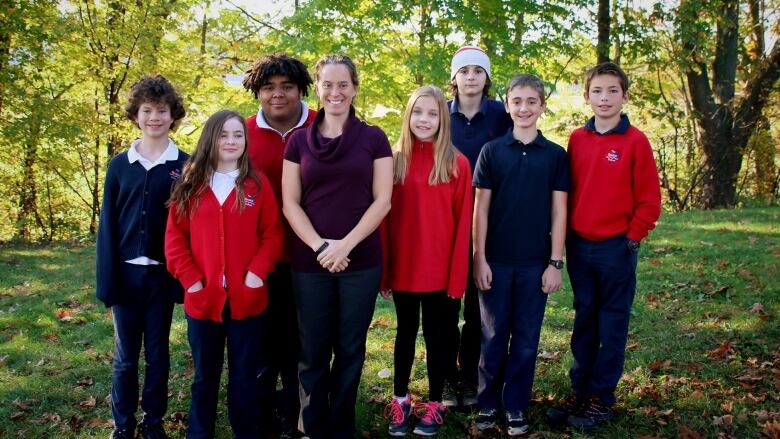Kids propose solution to Cornwallis statue woes
Students suggest taking Cornwallis off his pedestal and adding three other statues

The committee tasked with deciding what should happen to the statue of Edward Cornwallis in downtown Halifax hasn't even been appointed yet, and a solution to the controversy has already been found — by a group of pre-teens.
The class, at a non-profit independent school in Port Williams, N.S., called The Booker School, has researched, debated and decided on a solution to the problem.
The students, in grades 6 to 8, sent their proposal to the as-yet unnamed members of the special advisory committee on the commemoration of Edward Cornwallis and the recognition and commemoration of Indigenous history in a letter dated Dec. 13, 2017.
Their vision involves removing the statue of Cornwallis — a military officer credited with founding Halifax for the British in 1749 — from its pedestal in Edward Cornwallis Park in downtown Halifax, and adding three statues.
The commemoration of Cornwallis has become a point of contention due to his offer of a cash bounty to anyone who killed a Mi'kmaq person.
Removing the pedestal
At first, many of the students considered getting rid of the statue entirely, said 12-year-old class member Will Mercer. One person even suggested "shipping the Cornwallis statue to England," he told the CBC's Information Morning.
Ultimately, Mercer said, they decided that destroying the statue "would remove an important part of our history."

"We need to remember what happened," he said, "because if we forget, it helps no one in the long run."
Mercer's vision — which is the one that was ultimately backed by the other students following a series of negotiations — involved removing the Cornwallis statue from its pedestal as a way to "bring him down to earth," so that "what he did would not be glorified."
Three new statues
Mercer also proposed incorporating three new statues depicting important historical figures from diverse backgrounds:
- Grand Chief John Denny Jr., the last of the Mi'kmaq hereditary grand chiefs.
- Viola Desmond, a black Nova Scotian and symbol in the fight for racial equality.
- Noël Doiron, who has been described as the father of the Acadians.
He said he envisioned a circle with "four figures of equal stature facing each other, as if in a conversation." Each statue would have a plaque describing their "contributions and struggles," he added.

Teacher Temma Frecker said the plaques could even include questions for viewers "to really get them thinking."
The goal of the project, she said, was to recognize that certain perspectives are misrepresented or under-represented in Canadian history.
She said she wanted her students to understand that each version of history they hear depends "on who's telling the story."
In that respect, it appears she was successful. Mercer said the experience got him "thinking deeper about our history."
City responds
The adviser for Indigenous community engagement with the city of Halifax, Wyatt White, said he responded to the students via Twitter, calling it a "fantastic project."

This kind of "collaboration and dialogue," he said, "is what I'm striving for."
In an email to the CBC dated Jan. 5, municipal spokesperson Nick Ritcey confirmed that staff will present a report to councillors "in the coming weeks" on the final appointment of the committee members.
With files from the CBC's Information Morning

